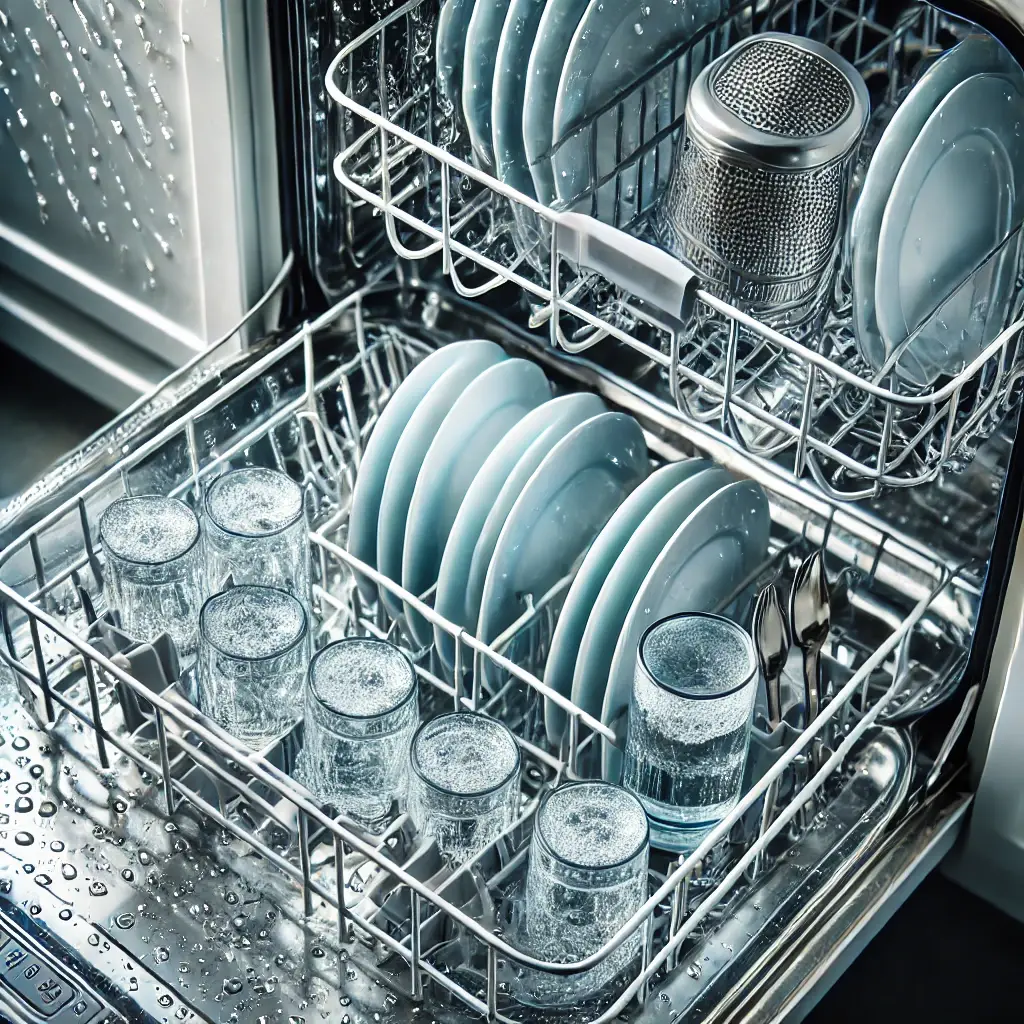Your home appliances work hard every day to make life easier, but over time, they can accumulate dirt, grime, and residue that affect their performance and longevity. Regular cleaning not only improves the efficiency of your appliances but also extends their lifespan. In this guide, we’ll share practical tips and tricks for cleaning your essential home appliances—helping you keep them running smoothly and looking spotless.
10 Genius Cleaning Hacks for a Spotless Home | How to Maintain Your Septic System: Tips and Tricks
10 Genius Cleaning Hacks for a Spotless Home | How to Clean and Maintain Your Home’s Exterior
How to Clean Your Refrigerator
The refrigerator is one of the most important appliances in your home, and keeping it clean is essential for food safety and efficiency.
Empty and Unplug the Fridge
Start by emptying the refrigerator, and discarding expired or spoiled items. Unplug the fridge to avoid using energy while cleaning and to let it defrost if there’s ice buildup.
Clean Shelves and Drawers
Remove all shelves and drawers, and wash them with warm, soapy water. Let them air dry completely before putting them back.
- Tip: For tough stains or stuck-on food, soak shelves in warm water and use a sponge or scrub brush to remove grime.
Wipe Down the Interior
Use a mixture of water and baking soda (about 1 tablespoon of baking soda per quart of water) to wipe down the interior of the fridge. This solution is effective at neutralizing odors and removing stains without leaving a harsh smell.
- Tip: Avoid using bleach or harsh chemicals inside the fridge, as they can leave harmful residues near your food.
Clean the Gasket and Door Seals
The rubber gasket around your refrigerator door can collect dirt and mildew. Clean it with a mixture of warm water and mild detergent, using a toothbrush to reach into the crevices.
- Tip: Apply a small amount of petroleum jelly to the gasket after cleaning to keep it supple and extend its lifespan.
How to Clean Your Oven and Stovetop
Ovens and stovetops often accumulate grease, food splatters, and burnt-on grime. Regular cleaning will help maintain their performance and prevent fire hazards.
Use the Self-Cleaning Function (For Ovens with This Feature)
If your oven has a self-cleaning function, follow the manufacturer’s instructions to use it. The self-cleaning cycle burns off residue at high temperatures, turning grime into ash that can be wiped away afterward.
- Tip: Always open windows or use ventilation when running the self-cleaning cycle, as it produces smoke and odors.
Manual Cleaning for Ovens Without Self-Cleaning
For ovens without a self-cleaning feature, use a baking soda and water paste to scrub the interior. Spread the paste over the walls and floor of the oven, let it sit for several hours (or overnight), then scrub and wipe clean with a damp cloth.
- Tip: For tough spots, use a mixture of vinegar and water in a spray bottle to mist over the baking soda before scrubbing.
Clean the Stovetop
For gas stovetops, remove the grates and burner caps, and soak them in warm, soapy water. Scrub them clean with a brush, then wipe down the stovetop with a mild cleaner or a mix of vinegar and water.
- Tip: For electric stovetops, use a non-abrasive cleaner and a microfiber cloth to remove burnt-on stains without scratching the surface.
How to Clean Your Dishwasher

Dishwashers can develop a build-up of food particles, grease, and hard water deposits, which can affect their cleaning performance. Here’s how to keep yours in top shape:
Clean the Filter
Start by removing and cleaning the dishwasher filter (usually located at the bottom of the machine). Rinse it under warm water to remove debris and food particles. If necessary, use a soft brush to scrub away grease.
Run a Vinegar Cycle
Pour a cup of white vinegar into a dishwasher-safe container and place it on the top rack of the dishwasher. Run a hot water cycle to dissolve grease and remove odors.
Use Baking Soda for Freshness
After the vinegar cycle, sprinkle baking soda over the bottom of the dishwasher and run a short, hot cycle. This will help deodorize the dishwasher and leave it smelling fresh.
- Tip: For deep cleaning, use a commercial dishwasher cleaner once a month to remove hard water deposits and keep the machine running efficiently.
How to Clean Your Washing Machine

Washing machines can collect mold, mildew, and detergent buildup over time, especially in front-loading models. Regular cleaning prevents odors and ensures your clothes come out fresh every time.
Clean the Detergent Dispenser
Remove the detergent drawer and soak it in warm, soapy water. Use a brush to scrub away any detergent residue or mold, and then rinse it thoroughly.
Run a Cleaning Cycle with Vinegar
Pour two cups of white vinegar into the detergent compartment and run a hot water cycle. This helps remove detergent buildup, bacteria, and odors inside the drum.
Wipe the Door Seal
For front-loading machines, the rubber door gasket can harbor mold and grime. Wipe it down with a mixture of vinegar and water, and use a cloth or brush to clean inside the folds of the gasket.
- Tip: Leave the washing machine door open after each use to allow air circulation and prevent mold growth.
How to Clean Your Microwave
Microwaves can quickly become messy with food splatters and grease. A simple cleaning routine will keep it hygienic and prevent lingering odors.
Steam Clean the Interior
Fill a microwave-safe bowl with water and a few slices of lemon or a tablespoon of vinegar. Microwave it on high for 3-5 minutes, then let it sit for a few minutes to allow the steam to loosen grease and grime.
- Tip: The steam makes it easier to wipe away stains with a damp cloth or sponge.
Clean the Turntable
Remove the microwave turntable and wash it in warm, soapy water. Dry it thoroughly before placing it back inside.
Wipe Down the Exterior
Use a damp cloth and a mild cleaner to wipe down the exterior of the microwave, including the control panel and handle.
Cleaning Your Small Appliances
Small appliances like coffee makers, toasters, and blenders need regular cleaning to ensure they function well and remain hygienic.
Coffee Maker
Run a cycle with equal parts water and vinegar to descale the coffee maker and remove mineral buildup. Run two cycles of plain water afterward to rinse the machine.
- Tip: Clean the coffee maker every month to maintain optimal performance.
Toaster
Unplug the toaster and remove the crumb tray. Shake out crumbs and wipe the tray clean. Use a small brush to clean any crumbs stuck inside the toaster slots.
- Tip: Be careful not to use metal tools inside the toaster to avoid damaging the heating elements.
Blender
Disassemble the blender and wash all parts in warm, soapy water. For stuck-on food, blend a solution of water, dish soap, and baking soda, then rinse thoroughly.
Summary Table: Cleaning Tips for Home Appliances
| Appliance | Cleaning Task | Tools/Products Needed |
| Refrigerator | Clean shelves, drawers, gasket | Baking soda, warm water, mild detergent |
| Oven | Scrub interior, clean stovetop | Baking soda, vinegar, dish soap |
| Dishwasher | Clean filter, run vinegar cycle | White vinegar, baking soda, dishwasher cleaner |
| Washing Machine | Clean drum, wipe door seal | White vinegar, soft brush, warm water |
| Microwave | Steam clean, wipe interior and exterior | Water, lemon or vinegar, damp cloth |
| Coffee Maker | Descale with vinegar, rinse with water | White vinegar, water |
| Toaster | Clean crumb tray, shake out debris | Small brush, cloth |
Conclusion
Regular cleaning of your home appliances is essential for keeping them running efficiently and extending their lifespan. With the right tools and a consistent cleaning routine, you can maintain a clean, hygienic, and functional kitchen and laundry space. By following the tips and tricks in this guide, you’ll save time, money, and ensure your appliances continue working at their best.
FAQs
Most appliances, like refrigerators and dishwashers, should be cleaned once a month. Small appliances, such as coffee makers, can be cleaned every 1-3 months, depending on usage.
Vinegar is a great natural cleaner for many appliances, but avoid using it on rubber gaskets (like in some washing machines) as it can wear them down over time.
Keep an open box of baking soda in your fridge to absorb odors, and regularly clean spills and expired food.
Yes! Detergent residue, fabric softener, and grime can build up over time, so regular cleaning is important to keep it fresh and functional.
Place a baking sheet under foods that might drip, like casseroles, to catch spills. Wipe up any messes as soon as the oven cools to prevent baked-on grime.





